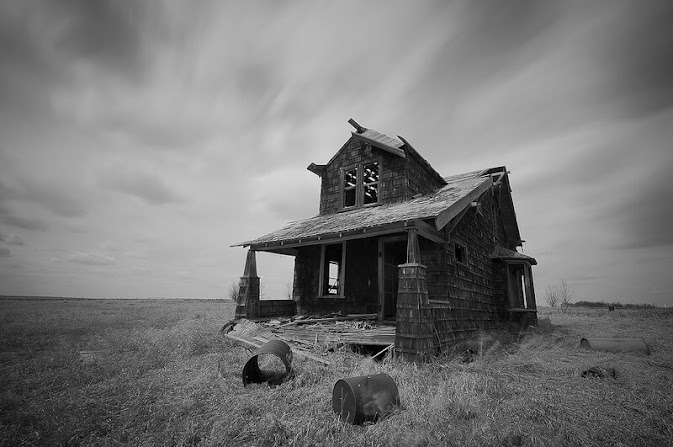“Come on, read my fortune for me.”
“You haven’t got any.”
“What do you mean?”
“Your future is all used up.” / “Break him! Break him!”
Film Noir is, even more than private detectives and femme fatales, focused on fated destruction, and a blurred sense of morality, which often makes it difficult to identify the true villains. Hank Quinlan is a Captain in the Police and has a long history of getting his man - through any means necessary. It is interesting to consider that there are many cases in Film Noir where the hero of the picture is someone who is acting on his own authority - often policemen or ex-policemen who step over the line to bring the villain to justice.
Think of Glenn Ford in Fritz Lang's The Big Heat: his wife murdered by the Mob, who are protected high up by corrupt police. Ford's character turns in his badge and sets off determined to settle things his way. In a skewed and perverse way, Hank Quinlan does the same: he brings criminals to justice, without a thought for how lawful his methods may be. This is an interesting aspect of Touch of Evil, in that it is revealed in the closing moments of the film that Quinlan was right about Sanchez. He did murder his father in law. Quinlan planted evidence, but he didn't have to. In adopting the philosophies of "the ends justify the means" and "an eye for an eye" however, another kind of evil is born. The way in which Orson Welles examines this, and how corruption sometimes begins with good intentions, is remarkably nuanced and well observed.
~ Quinlan's zeal to see Sanchez in the Death House also raises another compelling element of the story, which is the shaky foundation on which the death penalty is often built. Reminiscent of Orson's bravura performance in Richard Fleischer's 1959 Courtroom Drama, Compulsion, Touch of Evil affirms that the death penalty is final, and cannot be remedied, should new evidence come to light. All it takes is one Hank Quinlan and his "game leg" to put an innocent person to death. This should come as no surprise to those who followed Orson's career and life. He was a deeply principled man, as well as being, in my view, the greatest filmmaker who ever lived. ~
Charlton Heston, dodgy politics or not, is excellent as the closest thing to a hero that Touch of Evil has: Miguel Vargas, a special prosecutor from Mexico. Janet Leigh plays his wife Susan, and is the recipient of the darkest and most hateful acts of the movie. These scenes still shock the viewer, even though films have obviously gotten far, far more explicit in their depiction of this kind of assault, because of the masterful direction of Orson Welles, the astonishing cinematography of Russell Metty and Janet Leigh's wonderfully off balanced performance of a woman who has gotten in way over her head.
Touch of Evil, in its Reconstructed Cut from 1998, is Orson's greatest work. The way this movie gets under the skin of the viewer is remarkable. Creeping, sinister; even in daylight there is an ever present shadow across the world in which these characters inhabit. Touch of Evil is a masterpiece, from the incredible, long, opening shot that is so rightly celebrated, to the natural end result of the corruption of Hank Quinlan - cold blooded murder. Not only of, the admittedly villainous, Uncle Joe Grande - superbly realized by Akim Tamiroff - but of Quinlan's best friend and partner, Sergeant Pete Menzies. Menzies' heartbreak at his discovering the lengths to which his hero and mentor, Captain Quinlan has gone to get his man, is beautifully captured by Joseph Calleia. Pete followed his Captain as far as he possibly could, but could go no further.
The key performance in Touch of Evil though, is Orson Welles as Captain Hank Quinlan. Orson brings a tragic humanity to an abhorrent human being, in such a way as to make the film perhaps the purest definition of Noir. Quinlan's wife was murdered when he was just starting in the police. He was not able to get the man who did it. The profound pain in Orson's face when he remembers his wife brings to mind the phrase, "a picture is worth a thousand words". Everything about the character's motivations, and his long held reasons for acting the way he does, is all there in his face. It is of course natural to focus on Orson's remarkable gifts as a director, given his achievements and innovations in that role, but Orson's gifts as an actor, both in his own films and in those of others, should not be undervalued.
"Pete, that's the second bullet I stopped for you." / "Each man kills the thing he loves." - Oscar Wilde
The ending of Touch of Evil is the extinguishing of the last bit of good that existed in Hank Quinlan. He has murdered his best friend in an attempt to protect himself from justice finally being done on him. This ending is poetic and profound and deeply moving. Touch of Evil is, along with Billy Wilder's Sunset Boulevard, Nicholas Ray's In a Lonely Place and Roman Polanski's Chinatown, as pure a definition of what Film Noir is, as has ever been made. The tragedy and pain that grows from a seed of good intentions, and becomes the evil that the individual thought they were fighting in the first place. Orson Welles is too often dismissed as the man who made Citizen Kane, as if everything after that point was a let-down. While Orson's filmography does not contain a masterpiece every time out, each film is vital and full of creativity and ingenuity, and power and humanity. And none are more powerful or human than Touch of Evil; a truly great work of art by a master of the form.

.gif)



.gif)

No comments:
Post a Comment